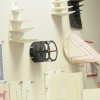
Classroom decorating adds many elements to making learning fun and relevant. Usually when walking into a classroom for the first time, one can identify themes and sources of creativity by looking at the classroom’s coordinated decorations. The students’ attention is instantly drawn to the posters and flyers plastered against the wall, images sketched in pencil, or perhaps references that are occasionally helpful. The primary purposes for which Aragon teachers decorate their rooms are to enhance learning experiences, highlight student works, and display personal mementos.
Teachers most commonly use posters, projects, and artwork to enhance their room and create a better visual learning setting. Science teacher Asif Rahman says, “[I] put creative or pleasant items [in the classroom]. They tell a little about my interests, what I like. It starts to give kids an impression of what has been done. I always endeavor to put free posters and artwork that students do.”
Math teacher Behrooz Shahrvini says, “I use student work from various classes … and motivational posters [to decorate my room].” The majority of teachers cover their walls with these objects, and they serve as sample works to help students gauge what to expect from these classes.
When English teacher James Daniel decorates, he says, “[I improve the classroom by] show[ing] how strange and powerful the English language is, [and making it] feel pleasant, not too bleak—pictures of kids, prom, movie posters, and various drawings.” Students get a sense of how their teachers are like outside the classroom and how they may connect with them.
Many students are accustomed to seeing the familiar posters and objects displayed in numerous classrooms around campus. Some of these decorations help ease students’ transition from teacher to teacher and keep a sense of creativity all the time. Sophomore Andrew Wang comments, “I love decorations because [they give] each classroom a unique taste and feel, rather than just having plain, white walls.”
However, sometimes students can be so preoccupied with lectures and classwork that the time teachers put into to the decor does not seem to be appreciated. “Once, I had red and black paper in the back [of the room]. [It] looked like a curtain. It was crazy and took a lot of effort, but people didn’t seem to notice or appreciate it,” Daniel says.
Students may have their own favorite classrooms based on decorations and the culture of them. Wang comments, “My favorite classroom to look at is the leadership class because of all the cool posters and things hanging on the wall; not a single part of the wall is not covered with something interesting.”
Freshman Caitlyn Chan comments, “I like Ms. Thurtle’s classroom [because of] the posters are funny and how she puts up projects. I also like how sometimes there’s a candle in the room, which all contributes to a pleasant learning environment.”
Despite all the elegance and creativity with decorations, there are also limits that apply; math teacher Adam Jacobs says, “[Teachers] can put anything up to a certain amount of space to the ceiling … and there is a guideline of a percentage of the wall to be covered by stuff.” These instructions are necessary due to safety matters, such as fire hazards.
Furthermore, classroom layout can be a hindrance to the addition of decorations. Science teacher Katherine Ward says, “I use posters related to the subject taught. There is not a lot of tackable space because the classroom is a working lab; it was not designed for a lot of poster space. [I decorated differently] when I had the wall space. I use the hallway [for decorations], and I also use labels to identify cabinet contents so students can find and locate things, [and become] self-sufficient. [Students] get used to looking for materials; it facilitates student use.”
By making the classroom more functional for students, it helps keep the students accountable for their own learning. Decorations create a positive impact on the learning community, and moreover, provide unique and intriguing flavor to the classrooms.







